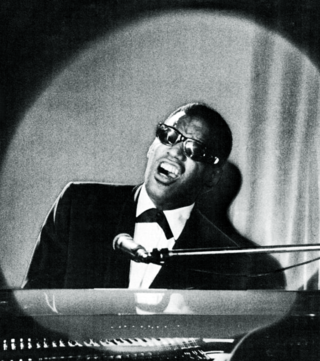Related Research Articles

Soul music is a popular music genre that originated in the African-American community throughout the United States in the late 1950s and early 1960s. It has its roots in African-American gospel music and rhythm and blues. Soul music became popular for dancing and listening, where U.S. record labels such as Motown, Atlantic and Stax were influential during the Civil Rights Movement. Soul also became popular around the world, directly influencing rock music and the music of Africa. It also had a resurgence in the mid-to late 1990s with the subgenre neo-soul, which added modern production elements and influence from hip-hop.
Jazz fusion is a popular music genre that developed in the late 1960s when musicians combined jazz harmony and improvisation with rock music, funk, and rhythm and blues. Electric guitars, amplifiers, and keyboards that were popular in rock and roll started to be used by jazz musicians, particularly those who had grown up listening to rock and roll.
Quiet storm is a radio format and genre of R&B, performed in a smooth, romantic, jazz-influenced style. It was named after the title song on Smokey Robinson's 1975 album A Quiet Storm.
Brit funk is a musical style that has its origins in the British music scene of the late 1970s and which remained popular into the 1980s. It mixes elements from jazz, funk, soul, urban dance rhythms and pop hooks. The scene originated in southern England and spread with support from DJs including DJ Froggy, Greg Edwards, Robbie Vincent, Chris Hill and Colin Curtis. Major funk acts included Jimmy James and the Vagabonds, Average White Band, Ian Dury & the Blockheads, Carl Douglas, Hot Chocolate, the Delegation, Hi-Tension, Light of the World, Level 42, Central Line, the Pasadenas, Beggar and Co and Soul II Soul. The genre also influenced 1980s new wave/pop groups such as Culture Club, Bow Wow Wow, Pigbag, Dexys Midnight Runners and Haircut 100.

Smooth jazz is a term used to describe commercially oriented crossover jazz music. Although often described as a "genre", it is a debatable and highly controversial subject in jazz music circles. As a radio format, however, it is clear that smooth jazz became the successor to easy listening music on radio station programming in the mid-1970s to the early 1990s.

Let's Get It On is the thirteenth studio album by the American soul singer, songwriter, and producer Marvin Gaye. It was released on August 28, 1973, by the Motown subsidiary label Tamla Records on LP.

Liquid funk, liquid drum & bass, liquid DnB, melodic drum & bass, or sometimes just liquid is a subgenre of drum and bass. While it uses similar basslines and bar layouts to other styles, it contains fewer bar-oriented samples and more instrumental layers, harmonies, melodies and ambiance, producing a sentimental atmosphere directed at home listeners as well as nightclub and rave audiences. Music genres such as jazz, soul and sometimes blues have a pivotal influence on liquid funk.

I Want You is the fourteenth studio album by American soul singer and songwriter Marvin Gaye. It was released on March 16, 1976, by the Motown Records-subsidiary label Tamla.

American popular music is popular music produced in the United States and is a part of American pop culture. Distinctive styles of American popular music emerged early in the 19th century, and in the 20th century the American music industry developed a series of new forms of music, using elements of blues and other genres. These popular styles included country, R&B, jazz and rock. The 1960s and 1970s saw a number of important changes in American popular music, including the development of a number of new styles, such as heavy metal, punk, soul, and hip hop.

Jazz-funk is a subgenre of jazz music characterized by a strong back beat, electrified sounds, and analog synthesizers. The integration of funk, soul, and R&B music and styles into jazz resulted in the creation of a genre that ranges from pure jazz improvisation to soul, funk or disco with jazz arrangements, jazz riffs, jazz solos, and sometimes soul vocals. Jazz-funk was popular in United States and United Kingdom. Similar genres include soul jazz, jazz fusion and acid jazz.
Dance-rock is a dance-infused genre of rock music. It is a post-disco genre connected with pop rock and post-punk with fewer rhythm and blues influences. It originated in the early 1980s, following the decline in popularity of both punk and disco.
Manila sound is a music genre in the Philippines that began in the mid-1970s in Metro Manila. The genre flourished and peaked in the mid to late-1970s during the Philippine martial law era and has influenced most of the modern genres in the country by being the forerunner to OPM.
Post-disco is a term to describe an aftermath in popular music history circa 1979–1986, imprecisely beginning with the backlash against disco music in the United States, leading to civil unrest and a riot in Chicago known as the Disco Demolition Night on July 12, 1979, and indistinctly ending with the mainstream appearance of new wave in 1980. During its dying stage, disco displayed an increasingly electronic character that soon served as a stepping stone to new wave, old-school hip hop, Euro disco, and was succeeded by an underground club music called hi-NRG, which was its direct continuation.

Boogie is a rhythm and blues genre of electronic dance music with close ties to the post-disco style, that first emerged in the United States during the late 1970s to mid-1980s. The sound of boogie is defined by bridging acoustic and electronic musical instruments with emphasis on vocals and miscellaneous effects. It later evolved into electro and house music.
City pop is a loosely defined form of American music-influenced Japanese pop music that emerged in the late 1970s and peaked in popularity during the 1980s. It was originally termed as an offshoot of Japan's Western-influenced "new music", but came to include a wide range of styles – including funk, disco, R&B, AOR, soft rock, and boogie – that were associated with the country's nascent economic boom and leisure class. It was also identified with new technologies such as the Walkman, cars with built-in cassette decks and FM stereos, and various electronic musical instruments.
References
- 1 2 3 4 5 6 allmusic: Smooth soul. All Media Guide, LLC. Retrieved on 2009-01-11.
- ↑ allmusic: Smooth soul - Top Albums. All Media Guide, LLC. Retrieved on 2009-01-11.
- ↑ allmusic: Pop-soul. All Media Guide, LLC. Retrieved on 2009-01-11.
- ↑ Smooth Soul|Soul Defined
- ↑ Smooth Soul CD Set (10 Discs) - As Seen on TV Report